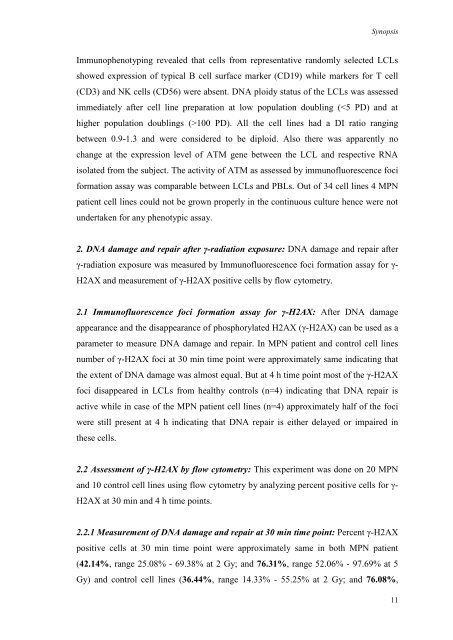LIFE09200604007 Tabish - Homi Bhabha National Institute
LIFE09200604007 Tabish - Homi Bhabha National Institute
LIFE09200604007 Tabish - Homi Bhabha National Institute
You also want an ePaper? Increase the reach of your titles
YUMPU automatically turns print PDFs into web optimized ePapers that Google loves.
Synopsis<br />
Immunophenotyping revealed that cells from representative randomly selected LCLs<br />
showed expression of typical B cell surface marker (CD19) while markers for T cell<br />
(CD3) and NK cells (CD56) were absent. DNA ploidy status of the LCLs was assessed<br />
immediately after cell line preparation at low population doubling (100 PD). All the cell lines had a DI ratio ranging<br />
between 0.9-1.3 and were considered to be diploid. Also there was apparently no<br />
change at the expression level of ATM gene between the LCL and respective RNA<br />
isolated from the subject. The activity of ATM as assessed by immunofluorescence foci<br />
formation assay was comparable between LCLs and PBLs. Out of 34 cell lines 4 MPN<br />
patient cell lines could not be grown properly in the continuous culture hence were not<br />
undertaken for any phenotypic assay.<br />
2. DNA damage and repair after γ-radiation exposure: DNA damage and repair after<br />
γ-radiation exposure was measured by Immunofluorescence foci formation assay for γ-<br />
H2AX and measurement of γ-H2AX positive cells by flow cytometry.<br />
2.1 Immunofluorescence foci formation assay for γ-H2AX: After DNA damage<br />
appearance and the disappearance of phosphorylated H2AX (γ-H2AX) can be used as a<br />
parameter to measure DNA damage and repair. In MPN patient and control cell lines<br />
number of γ-H2AX foci at 30 min time point were approximately same indicating that<br />
the extent of DNA damage was almost equal. But at 4 h time point most of the γ-H2AX<br />
foci disappeared in LCLs from healthy controls (n=4) indicating that DNA repair is<br />
active while in case of the MPN patient cell lines (n=4) approximately half of the foci<br />
were still present at 4 h indicating that DNA repair is either delayed or impaired in<br />
these cells.<br />
2.2 Assessment of γ-H2AX by flow cytometry: This experiment was done on 20 MPN<br />
and 10 control cell lines using flow cytometry by analyzing percent positive cells for γ-<br />
H2AX at 30 min and 4 h time points.<br />
2.2.1 Measurement of DNA damage and repair at 30 min time point: Percent γ-H2AX<br />
positive cells at 30 min time point were approximately same in both MPN patient<br />
(42.14%, range 25.08% - 69.38% at 2 Gy; and 76.31%, range 52.06% - 97.69% at 5<br />
Gy) and control cell lines (36.44%, range 14.33% - 55.25% at 2 Gy; and 76.08%,<br />
11

















